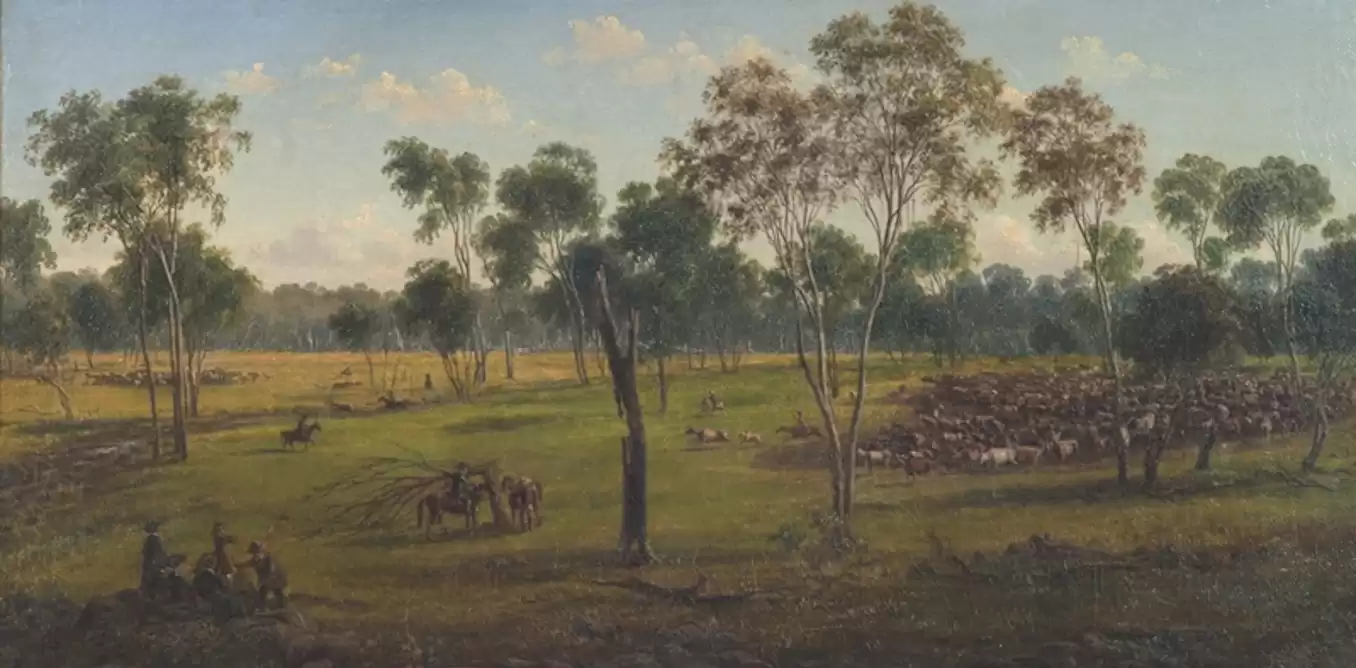Colonists Impact Aboriginal Farming, Introducing Grain and Sheep on Yamfields, and Cattle on Arid Grainlands
The effects of colonialism in Australia are still present today, as the land was taken from Indigenous people and used for European farming practices. This led to the loss of native crops and the decline of many species.
In 1788, when the First Fleet arrived in Australia, they brought with them two bulls and four cows from the Cape of Good Hope. These animals were placed on Bennelong Point, where the Sydney Opera House now stands. However, the land did not have much grass, and what was there was not of good quality. As a result, the cattle wandered off and were found seven years later, 65 kilometers southwest in the Cowpastures near Camden. By 1820, there was a flourishing herd in the area, supporting an abattoir and tanneries.
The reason the cows stayed in the Cowpastures was because they had found land that had been intentionally managed by the Dharawal people. These Indigenous managers had performed cool burns to promote the growth of rich grass near water, which attracted the cattle. However, this also marked the beginning of dispossession for the Indigenous people. The grazing animals trampled on or ate the staple tubers, such as murnong, that the local groups relied on. These tubers grew in rich beds but were easily damaged by the cattle. As the colonists moved inland, they took over Aboriginal land that had been used for growing grain and replaced it with sheep or cattle.
The effects of this dispossession can still be seen today. The newcomers who took over the Camden country tried to keep it open without scrub. However, they did not understand fire management, and the bush quickly became overgrown. By 1817, the Macarthurs' land was crowded with thickets of saplings and thorn bushes, and the grass was choked by underwood. This lack of fire management allowed the trees to take over, transforming open forest lands into dense forests.
On the other hand, the European crops did not thrive on the Sydney sandstone. In 1789, English farmer James Ruse managed to grow corn on better land near Parramatta, but the yield was still poor. It wasn't until Ruse moved to the rich flats of the Hawkesbury River that he produced the first successful wheat crop. Soon, corn, wheat, and barley were supplying government stores and the Sydney market.
The Hawkesbury flats were also the land where the Dharug people had been growing tubers, a key staple for them. They could not afford to lose this land, but the settlers wanted it all. In 1794, a guerrilla war broke out between the Indigenous people and the settlers, lasting for 22 years. The settlers eventually prevailed, and the Indigenous people were forced off their land.
Unlike the newcomers, the Dharug people rarely ate grain. They preferred tubers, which were a common staple in wetter regions of Australia. Women would regularly dig over tuber fields to make the soil crumbly and replant tuber tops for the next harvest. The ground where they worked looked ploughed for miles. In drier regions, people grew grain, such as native millet, near water sources. They used fire to prepare the land, spread the seed, blocked channels to spread water, and harvested the crop.
Since colonization, the way we use the land has essentially reversed. In 1788, people farmed more of Australia than we do now. The arid interior, which was once used for widespread grain farming, is now left to cattle or camels. Our crops now largely grow on tuber country, leading to the decline or disappearance of many tuber species. This change in land use has also had a significant impact on wildlife. Ground-dwelling mammals and birds have declined, with many species becoming extinct or endangered. The introduction of stock and new predators like cats and foxes has contributed to this decline.
The Indigenous people who cared for these species were devastated by the invasion and dispossession. They lost their land and the ability to manage it carefully. Their knowledge of the land, sea, and sky, as well as their skills in growing crops and husbanding native animals, were lost. Today, we are left with the remnants of what was once a rich and diverse ecosystem.











Comments on Colonists Impact Aboriginal Farming, Introducing Grain and Sheep on Yamfields, and Cattle on Arid Grainlands